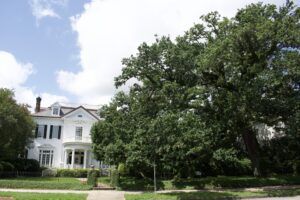Plotting the possibilities – Urban and school gardens are on the rise in Baton Rouge
At the One Stop Homeless Services Center in downtown Baton Rouge, clients gather outside each morning, waiting their turn to use the laundry facilities, showers and computers, or to meet with case workers. Many have walked across the street from the Society of St. Vincent de Paul shelter and dining room, which serves three meals a day to the local homeless community. The pain and suffering here at the corner of Convention and North 17th streets are palpable—but the site is not without natural beauty. Last year, volunteers helped install a community garden in an overgrown lot on the center’s south side.
“A lot people told us it wouldn’t work, and that people would just vandalize it,” says organizer Maggie Conarro. “But it really has become this sacred space that everyone respects and enjoys.”
In October 2012, Conarro, along with staff and volunteers from the One Stop center and First United Methodist Church, cleared the lot, then badly overgrown with wild foliage and strewn with litter. They installed two 4-by-8-foot garden boxes and planted leafy greens and fall herbs, which grew undisturbed. Litter may have continued to gather on the large lot’s periphery, but the two boxes—perched in the center like beacons—remained unscathed. By this spring, the garden had been so well-received by clients and volunteers that organizers added two more 4-by-8-foot boxes, two new brick-lined beds, and an installation of recycled, functional art—stacked rubber tires painted in vibrant colors. Filled with dirt, they’re used as flower pots.
One Stop Homeless Services Center Executive Director Randy Nichols says the garden has had several positive results. Clients have gotten involved in the maintenance and harvest, and it has helped attract more involvement from the public.
“Among other things, it gives people in the community a way to connect and volunteer with the center,” he says.
Indeed, the garden is achieving the primary goal of a community garden—building community—and it is by no means isolated in Baton Rouge. Urban agriculture is on the rise here, with more homeowners planting backyard gardens and more local community and school gardens taking root. It follows a national trend in which dormant plots of earth everywhere are slowly being reclaimed and redefined. For example, the thriving, lush “Beauregarden” on an East Boulevard median between Government Street and North Boulevard is a successful joint project between First United Methodist Church and the Beauregard Town Civic Association. The garden has added beauty and has fostered stronger relationships between residents of this historic Baton Rouge neighborhood.
Meanwhile, school gardens are becoming a popular means for instructors to explore math, science and writing in fresh, tangible ways. St. Aloysius Catholic School, University Terrace Elementary School, Lanier Elementary, Glasgow Middle, Polk Elementary, Capitol Middle and the University Laboratory School have some well-established school gardens in Baton Rouge. And in July and August, the city-parish hosted a new summer work program in which young people planted gardens in five depressed areas in north Baton Rouge.
According to the American Community Garden Association, there are more than 18,000 established community gardens in the country, and the number is growing every day. Gardens are attractive to communities and schools for several reasons. They increase property values, reduce crime, expand school curricula, bring together intergenerational volunteers, and fundamentally focus everyone’s attention on a common, positive goal.
“There’s a lot of interest in community gardening right now,” says LSU horticulture professor Carl Motsenbocker, co-founder of Slow Food Baton Rouge. “We get calls all the time from groups interested in starting gardens.”
Slow Food Baton Rouge is part of Slow Food USA, a global grassroots organization that advocates for good, clean and fair food. The Baton Rouge chapter got started four years ago, and its varied projects include hosting a series of urban agriculture workshops on such topics as organic seasonal gardening, raising chickens, establishing apiaries, growing citrus and others. Conarro, an AmeriCorps volunteer with Slow Food Baton Rouge, has spent the last year developing the center’s new garden and forming maintenance and sustainability plans for other, existing gardens.
The LSU AgCenter is also an important resource for those creating urban gardens, especially school gardens. Its extension agents are on hand to work with schools around the state, and it also provides manuals for schools interested in establishing either vegetable gardens or butterfly gardens.
“School gardens are becoming very popular not only with teachers but students as well. Engaging children in nature helps them gain appreciation for our natural resources,” says AgCenter horticulturalist Kathryn Fontenot.
At the University Laboratory School, it’s hard for students to walk through the campus courtyard without noticing what’s growing in Cub Garden, a collection of plots positioned just outside of the cafeteria and the elementary wing that hold seasonal fruits, vegetables, flowers and herbs the students help plant and harvest. In the fall and winter, the garden features carrots, broccoli, Swiss chard and strawberries. When those crops are spent and composted, students, teachers and parent volunteers replace them with tomatoes, pole beans, cucumbers, okra, basil and other heat-tolerant plants.
Cub Garden was established in 2008 under the direction of environmental sciences instructor Steve Babcock, who worked with students to design an initial garden plan. The school’s parent-teacher organization raised money to construct the garden, and since then it has quietly grown to include additional beds, composting mechanisms and rainwater catchments.
Organizers say the garden provides many different positive by-products, including concrete opportunities for students and teachers to discuss nutrition and the American food system. Last year, parent volunteer Cricket Gordon harvested fresh broccoli and brought platefuls of florets and ranch dressing to kindergarten classrooms to demonstrate where vegetables come from. Moreover, Cub Garden has been a catalyst for charitable giving. Elementary and middle-school students recently harvested more than 50 pounds of carrots and other vegetables, and donated them to the St. Vincent de Paul dining room, where cooks integrated them into the week’s menu.
“The garden can be anything you want it to be, from a math and science classroom, to a place that inspires art, charity or a culinary dish,” says Renee Verma, a Lab School parent and chair of the School Garden Committee.
Gardens aren’t without their challenges, say Conarro and Motsenbocker. It’s important to have an arrangement for maintaining a garden once it gets started.
“You need to start small and have some kind of plan about who is going to be in charge long-term,” says Conarro. “You have to have people who are knowledgeable about what to plant and when to plant it, and who are also good with people.”
Groups should also be aware that at certain points during the growing season, gardens look unsightly. Tomato plants wither in the late summer heat. Winter lettuces bolt. Herbs go to seed. This can be eased by making sure volunteers take regular rotations for weeding and clearing expended plants. And groups can also install aesthetic barriers such as hedgerows or public art, says Motsenbocker. Some schools or organizations may opt for butterfly gardens, which are easier to maintain because they largely consist of perennials. They just need to be organically grown in order to attract pollinators.
“Part of the experience of working in a garden,” says Motsenbocker, “is simply learning to work with nature.”











